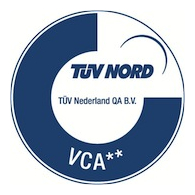WORKING PRINCIPLE
In the first Galicos-module (the evaporator) the liquid is led as a thin film shaped stream at increased temperature over a number of inclined plates.
These plates are equipped with a large amount of specially shaped openings which are in the direction of the fluid flow.
The gas (e.g. air) is mixed as elongated bubbles and carried away with the liquid flow.
The intensive gas-liquid contact causes an extremely good exchange of components and/or thermal energy.
During mixing the gas is heated and will be saturated with vapor.
After separation, the gas is led to an identical second Galicos-module (the condenser). Here, the gas cools down and the vapor condenses in a cooled condensate stream.
The continuous recirculation of gas through both devices leads to a continuous process of evaporation and condensation.
Typical for this process is that distillation takes place at atmospheric pressure and small temperature differences , that are far below the boiling point.
Unlike (vacuum) distillation by boiling, cooking bubbles and scaling on heating surfaces do not occur.

The Galicos modules can easily be connected with the inlet and outlet openings of the gas stream, leading to a simple but unique (patented) distillation system.
Features
- Evaporation at atmospheric pressure and low temperatures
- No fouling by scaling
- Easily cleanable
- Low energy consumption
- Simple operation and maintenance
- Modular expandable



